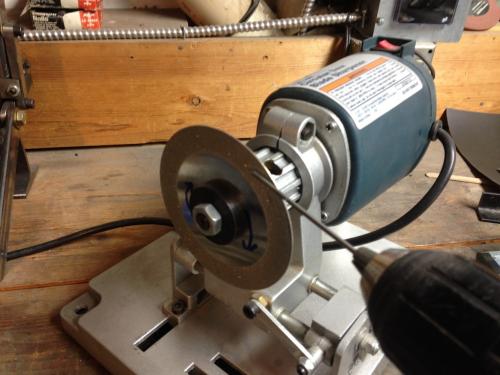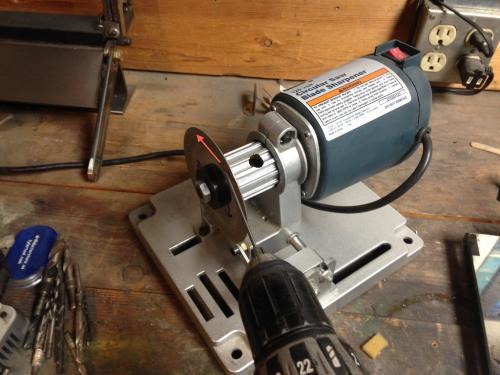Posts: 4,367
Threads: 177
Joined: Feb 2012
Location: Missouri, USA
No doubt about it, go to any welding forum and you'll find all kinds of arguments over how to sharpen a tungsten electrode. 
Everyone has their own preferences and way of doing things and if it works for you, run with it. If it isn't working, chances are you need to change something. 
I agree with keeping a box of tungsten's sharpened up and just swapping them out when you booger one up. Saves a lot of time over pulling the same one out of the torch over and over to cut it off and resharpen it each time.
Willie
Posts: 3,795
Threads: 183
Joined: Jun 2012
Location: Farmington Hills, Michigan
The following 1 user Likes TomG's post:
f350ca (02-14-2016)
Generally, an electrode is tapered a bit for steel (not to a sharp point) and supposedly the grind lines should be parallel to the electrode to guide the arc. Not sure it really helps, but I do it that way anyway. Electrodes for aluminum require a balled tip created by drawing an arc off a piece of copper using reverse polarity. Use smaller electrodes and balls or tips (for steel) for lower amperage and the opposite for higher amperage.
Tom
Posts: 4,367
Threads: 177
Joined: Feb 2012
Location: Missouri, USA
Food for thought:
Why is it do you suppose that the ridges on an electrical insulator run round and round (horizontally) instead of vertically? 
![[Image: 43684215-electrical-insulators-at-an-ele....jpg?ver=6]](http://us.123rf.com/450wm/petervick167/petervick1671508/petervick167150800042/43684215-electrical-insulators-at-an-electrical-sub-station.jpg?ver=6)
![[Image: 2]](http://contentinfo.autozone.com/znetcs/product-info/en/US/ngk/5553/image/2/)
Again, tungsten prep is akin to talking about politics or religion. It's a hot button issue. If it works for you - use it. But you have to realize that there are different types of machines these days - inverter v.s. transformer, sine wave, square wave, triangular wave - and behave differently. Just saying. 
Running an .040 electrode at 5 amps is always fun. 

Willie
Posts: 8,739
Threads: 313
Joined: Feb 2012
Location: Arizona/Minnesota
(02-14-2016, 12:16 AM)Roadracer_Al Wrote: Turns out that when your tungsten gets down to about 1" and is too short to hold in a torch, putting a point on the electrode and slipping it into your antique, obsolete lead holder makes a really nice scribe for doing layout tasks, and they stay sharp a really really long time.
That's a good tip (pun intended). 
Ed
Posts: 691
Threads: 14
Joined: Feb 2015
Location: Oakland, California
Posts: 3,795
Threads: 183
Joined: Jun 2012
Location: Farmington Hills, Michigan
Willie,
I believe insulators are made that way to increase the distance the electricity would have to travel over the surface to get to ground. A longer distance means less leakage. But I still sharpen my electrodes axially. 
Tom
Posts: 4,367
Threads: 177
Joined: Feb 2012
Location: Missouri, USA
Yeah, that's what I thought. But that is for an insulator, not an electrode that you want to flow current easily.
Every single welding text I have says to grind electrodes axially. So I do. 
Path of least resistance and all that....
Willie
Posts: 432
Threads: 27
Joined: Feb 2016
Location: Woodstock:GA
02-14-2016, 07:54 PM
(This post was last modified: 02-14-2016, 07:57 PM by pepi.)
Grinding tungsten ...... the best part of learning Tig welding. The profile on the tip has much to do with arc wonder and the heating area of the puddle.
As mentioned using a bench grinder to sharpen the tungsten will put a grove in the wheel real fast, and will/can contaminate the electrode with other metal particles in the stone that have been left behind.
Here are some things I learned and maybe helpful or at least food for thought. Diamond wheels are the best bang for the buck. I bought a HF chain saw chain sharpener, the diamond wheel is 10 bucks to replace. The sharpener is about 45 bucks, tungsten sharpeners cost ridiculous prices @ 250 and north. Look like a Dremel tool with a diamond wheel the size of the dremel cut off disk. Bought one used it for a short while sold it, found zero advantage for that purpose built tool.
Below, my answer for grinding electrodes quickly, allows me to experiment with the angle and length the profile, using a drill to turn the electrode. You will read when grinding the electrode you want the grind marks to have a linear pattern down too the tip, if they go around the arc will wonder. So low and slow RPMs of the drill.
Have no fear you are going to learn how to grind the electrode, the only other thought to pass. Tig is exactly the same a O A, or gas welding, if you have that experience you will pick up the Tig process very quickly.


Arrow show direction of the wheel, throws dust away from the operator
Magazines have issues, everything else has problems
Posts: 4,367
Threads: 177
Joined: Feb 2012
Location: Missouri, USA
The following 1 user Likes Highpower's post:
arvidj (02-15-2016)
(02-14-2016, 07:54 PM)pepi Wrote: Here are some things I learned and maybe helpful or at least food for thought. Diamond wheels are the best bang for the buck. I bought a HF chain saw chain sharpener, the diamond wheel is 10 bucks to replace. The sharpener is about 45 bucks, tungsten sharpeners cost ridiculous prices @ 250 and north. Look like a Dremel tool with a diamond wheel the size of the dremel cut off disk. Bought one used it for a short while sold it, found zero advantage for that purpose built tool.
That is a nice looking tool you have assembled there pepi.
While I know cost is usually the #1 factor in most folks minds regarding a tool that is a "uni-tasker" (~ Alton Brown) and I can completely relate to that - I will say that I do find an advantage in using one of those ridiculously priced Dremel tools. They are small and don't take up any space. That and the fact that I can cut & resharpen a tungsten right there at my welding table, without ever having to get up from my stool to go retrieve a drill motor and walk over to the work bench to use a grinder or belt sander. I can hang it on the side of my welder or the table. I like that. (My TIG welder has a built in electrical outlet in the front panel.) Saves me time and more wear and tear on my already worn out knees. 
I know it's not the most popular choice, it's just my choice. Everyone is free to make their own. 
What amazes me is the number of people that will grind on a tungsten electrode with an alox grinding wheel or belt sander, yet would never, ever dream of touching a carbide lathe tool to anything but a diamond wheel. 
With regard to TIG being exactly the same as Oxy/Acetelyne welding..... I can honestly say that I have never had to regrind a welding torch tip - ever - after dipping into the puddle a bit. 
Willie
Posts: 723
Threads: 34
Joined: Feb 2012
Location: Minneapolis, MN
The following 2 users Like arvidj's post:
EdK (02-15-2016), Highpower (02-15-2016)
(02-15-2016, 09:06 AM)Highpower Wrote: (02-14-2016, 07:54 PM)pepi Wrote: Here are some things I learned and maybe helpful or at least food for thought. Diamond wheels are the best bang for the buck. I bought a HF chain saw chain sharpener, the diamond wheel is 10 bucks to replace. The sharpener is about 45 bucks, tungsten sharpeners cost ridiculous prices @ 250 and north. Look like a Dremel tool with a diamond wheel the size of the dremel cut off disk. Bought one used it for a short while sold it, found zero advantage for that purpose built tool.
...
While I know cost is usually the #1 factor in most folks minds regarding a tool that is a "uni-tasker" (~ Alton Brown) and I can completely relate to that - I will say that I do find an advantage in using one of those ridiculously priced Dremel tools. They are small and don't take up any space. That and the fact that I can cut & resharpen a tungsten right there at my welding table, without ever having to get up from my stool to go retrieve a drill motor and walk over to the work bench to use a grinder or belt sander. I can hang it on the side of my welder or the table. I like that. (My TIG welder has a built in electrical outlet in the front panel.)
...
With regard to TIG being exactly the same as Oxy/Acetelyne welding..... I can honestly say that I have never had to regrind a welding torch tip - ever - after dipping into the puddle a bit. 
Willie,
I agree with the your Dremel assessment. I like mine for the same reasons you have stated.
The other significant "TIG vs OA" difference is that it is much easier to find outlets that support the voltage and current requirements of OA than the TIG welder. Cutting with TIG is also challenging. However the tanks do seem to be empty with the same 'inconvenient' timing with both technologies.
And in my case I can't do either worth a d..n.
Arvid
|









![[Image: TomsTechLogo-Profile.png]](http://tomstechniques.com/wp-content/uploads/2013/11/TomsTechLogo-Profile.png)

![[Image: 43684215-electrical-insulators-at-an-ele....jpg?ver=6]](http://us.123rf.com/450wm/petervick167/petervick1671508/petervick167150800042/43684215-electrical-insulators-at-an-electrical-sub-station.jpg?ver=6)
![[Image: 2]](http://contentinfo.autozone.com/znetcs/product-info/en/US/ngk/5553/image/2/)




